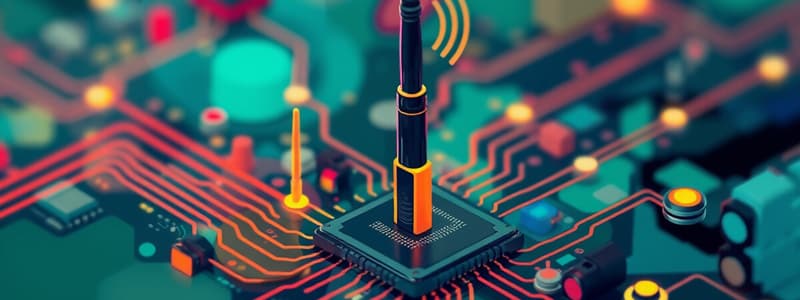Podcast
Questions and Answers
What is the primary function of smart things in the IoT framework?
What is the primary function of smart things in the IoT framework?
- To manage the connectivity of various devices
- To store and analyze data in the cloud
- To provide mobile interface for users
- To collect and transmit sensor data (correct)
What role does the IoT gateway play in the network?
What role does the IoT gateway play in the network?
- It solely stores massive amounts of data for analysis
- It replaces the need for end-user devices
- It connects sensor devices to the cloud and preprocesses data (correct)
- It coordinates the management of smart devices exclusively
Which statement accurately describes the function of the IoT cloud?
Which statement accurately describes the function of the IoT cloud?
- It primarily serves as a physical device to connect sensors
- It enables direct communication between smart devices without middleware
- It is responsible for the operation of traditional wired networks
- It stores, processes, and manages large sets of data for analysis (correct)
Which of the following describes the relationship between the coordinator and the IoT gateway?
Which of the following describes the relationship between the coordinator and the IoT gateway?
How does an IoT application enhance the customer experience?
How does an IoT application enhance the customer experience?
Which aspect of IoT security involves protecting the physical devices themselves?
Which aspect of IoT security involves protecting the physical devices themselves?
What does the pairing of smart things with a controller device ensure in an IoT system?
What does the pairing of smart things with a controller device ensure in an IoT system?
Which action is primarily performed to keep the firmware of smart devices updated?
Which action is primarily performed to keep the firmware of smart devices updated?
What process involves configuring smart things through a controller in IoT systems?
What process involves configuring smart things through a controller in IoT systems?
In the context of IoT systems, what is performed on Edge devices or Fog nodes to gather insights?
In the context of IoT systems, what is performed on Edge devices or Fog nodes to gather insights?
Flashcards are hidden until you start studying
Study Notes
IoT Smart Things
- Smart things consist of sensors, communication interfaces, operating systems, and actuators responsible for data collection and transmission.
- They transfer sensor data to a connected coordinator or gateway.
Coordinator
- Manages multiple smart devices and sensors, ensuring effective communication and control.
Networking Infrastructure
- Comprises various wired and wireless networks (e.g., Wi-Fi, Bluetooth, ZigBee, LoRaWAN) enabling connectivity of smart things to IP-based networks through IoT gateways.
IoT Gateway
- Can be a physical device or software facilitating connectivity between sensor devices, coordinators, and the IoT Cloud.
- Preprocesses sensor data at the edge, including compression to minimize transmission costs.
- Translates different network protocols to enhance interoperability among smart things.
IoT Cloud
- Consists of high-performance servers designed to store, process, and manage large volumes of data for analysis.
End-User Devices
- IoT applications are accessible through mobile and computing devices, prioritizing user-friendly interfaces to enhance customer experience.
IoT Applications
- Available globally, covering a broad spectrum from home automation to industrial automation.
- Encompass various security measures: physical device security, data security, network security, and cloud security to protect against specific IoT attacks.
Security Challenges
- Implementing security across diverse IoT devices is complex and requires understanding of unique constraints.
- Comprehensive security approaches must include identification of IoT components and an end-to-end perspective to align functionalities with system components.
Key Functionalities in IoT Systems
- Firmware Upgrading: Keeping smart things updated with the latest code for optimal sensing.
- Pairing: Connecting smart things with the controller device (IoT Coordinator).
- Binding: Configuring smart things for Internet access through the controller.
- Local Authentication: Verifying the controller on a dedicated port of a smart thing.
- Local Control: Commanding smart things via the controller using local wireless connection.
- Remote Authentication and Control: Needed when a controller is connected to smart things over the Internet.
- Sensing and Notifications: Smart things alert the controller with relevant data.
- Data Analytics: Performed on edge devices or fog nodes, while big data analytics occurs on the cloud.
Studying That Suits You
Use AI to generate personalized quizzes and flashcards to suit your learning preferences.




